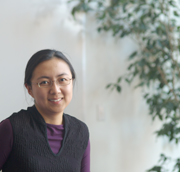Some LIDS students have always known they were MIT-bound. For Lillian Dai, however, the road to LIDS has been a long and winding one. From China to Canada and now Cambridge, Lillian’s love for learning has brought her to diverse fields of study, a wide range of extracurricular interests, and a belief in the interdisciplinary nature of LIDS.
Lillian was born in Xining, in the Qinghai province of China near Tibet, an area she calls “remote,” and moved to Calgary, Alberta at age eleven with her family. The transition was difficult for her. “I didn’t speak a word of English,” she says. “I knew my ABCs, but that was it.” Though her English skills were limited, Lillian excelled in math, a subject that needed no translation. As Lillian’s English improved, she also shone in other subjects and briefly considered careers in medicine, environmental engineering, and music before enrolling at the University of Calgary to study electrical engineering. During her fourth year there, Lillian worked with a professor on a satellite communications project, and though she had little experience with communications, she quickly became hooked. When she learned that members of the LIDS faculty were researching satellite communications, she applied. Before making her decision, Lillian came to visit the lab and to meet with faculty. “I was so impressed,” she says, “I decided right then that I was coming to LIDS.”
Lillian’s research emphasizes an interdisciplinary approach. “I think it’s the right thing to do,” Lillian says. “When you design a communications system, you can’t just focus narrowly on one small aspect; you need to look at the whole picture.” That picture may include disciplines beyond communications, as in Lillian’s master’s thesis, which addressed satellite link design from a cost perspective. Her current PhD research requires an even greater perspective. Lillian works to resolve the “inherent problem” of unreliability in existing infrastructureless wireless networks. She describes the scope of the problem as “huge,” involving not only communications and networking, but also optimization, control, and signal processing. In short, “everything at LIDS.”
Infrastructureless wireless networks, like those Lillian researches, are temporary wireless networks that can be deployed rapidly anywhere and anytime “without having to deploy fixed network infrastructures ahead of time.” This means that no fixed base stations or access points need to be built and installed, unlike cellular and Wi-Fi networks. Like walkie-talkies, the devices in an ad-hoc network communicate via radio waves and can only “talk” to other devices within a particular distance. Unlike walkie-talkies, each device “acts as a relay for other people’s communication” in order to extend the range of the network. Information “hops” from one mobile device to the next, until it reaches its intended destination; the more devices participating in the network, the greater the potential for extending the network’s range. As people move, along with the devices that they use, the topology, or geographic structure, of the network continuously adjusts, changing the route that information will take.
One type of infrastructureless wireless network under intensive study is the ad-hoc wireless network, which, as the name implies, offers ad-hoc or best-effort service to devices in a network. As devices move, ad-hoc wireless networks may become disconnected, and hence cannot guarantee that time-critical information will reach the intended recipients in a timely manner. For many applications such as communication during disaster relief efforts, search and rescue missions, and special operations in the military where timely delivery of information is often a matter of life and death, new wireless architectures must be developed. Lillian names the aftermath of Hurricane Katrina as a key example. “All of the communication infrastructures were down,” Lillian points out, and “a lot of the disaster relief coordination issues had to do with a lack of communication.” By reliable infrastructureless wireless networks, she suggests, rescue workers and police could have maintained communication throughout the devastated city.
Creativity and interdisciplinary thinking provide potential solutions to the problem of unreliability in existing ad-hoc wireless networks. Lillian proposes “a new infrastructureless wireless network architecture called Proactive Mobile Wireless Networks,” an approach that goes beyond improving the usual communication resources by incorporating proactive network state prediction and adaptive helper node insertion and trajectory control. These helper nodes could be fixed relay devices randomly scattered in a region or mobile access points mounted on vehicles, hot air balloons, or in the future, even robots. With the ability to predict disconnection times and locations, and with helper nodes enabling connection among devices that would otherwise be disconnected, there is a better chance that all the participants in the network can stay connected and messages communicated successfully. Yet Lillian’s problem doesn’t end here. The other half of her research involves optimizing communication and network resources at each device, by using more advanced antennas on mobile devices and finding energy efficient routing paths to prolong battery life-time. “I have built the architectural framework,” Lillian says of her research. “Eventually it will take a lot more effort than just me alone to refine the details.”
Lillian’s passion for knowledge doesn’t end at the lab. “I really feel that to be a good engineer you need to be well-rounded,” she says of her many extracurricular activities. Lillian’s advice to future students echoes this sentiment: “Be curious: MIT is like a treasure box and you should pick up as many treasures as you can.” In the past few years, Lillian has been an officer in the Science and Engineering Business Club, served as music chair and trustee for the Sidney-Pacific dormitory, and founded both MIT VentureShips, an organization that connects students seeking business experience with MIT-affiliated start-up companies, and MentorConnection, a one-to-one mentoring program which matches students with successful MIT alumni. Lillian’s newest project is the creation of a LIDS Facebook group, in order to increase interaction within the lab. Using Facebook, a social networking site geared toward students, LIDS students and staff can organize movie nights and dinners, or notify group members of upcoming LIDS soccer games. Lillian hopes more alumni will join the group as well, further enhancing networking opportunities.
Lillian also makes a point to attend different events and talks on campus. “That’s what makes MIT special,” she explains. “You can invite these great people and they will come and share their stories….When I first came here, I didn’t know very much about research or about the world. I felt like I was living in a fog and there were only bits of light coming through.” Her ambition and zest for knowledge guarantee those bits of light will continue to grow, and she hopes, brighten others’ lives. Lillian looks forward to collaborating with other talented young researchers in the future because, she affirms, “together, we can make a stronger impact.”




